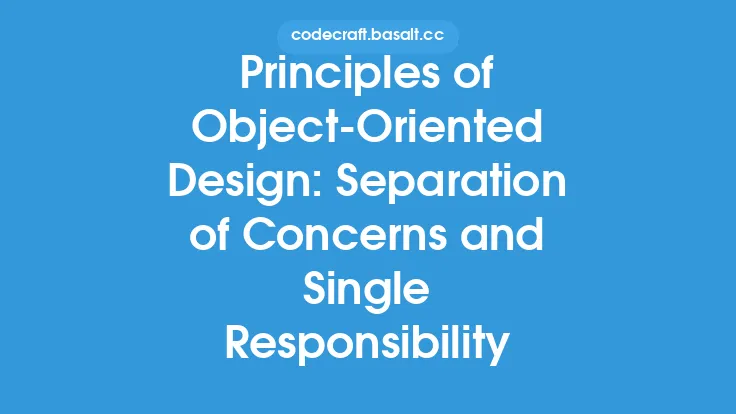The SOLID principles of object-oriented design are a set of guidelines that aim to promote cleaner, more robust, and maintainable code for software development. These principles were first introduced by Robert C. Martin, also known as "Uncle Bob," who is a well-known expert in the field of software engineering. The SOLID principles are composed of five individual principles: Single Responsibility Principle (SRP), Open-Closed Principle (OCP), Liskov Substitution Principle (LSP), Interface Segregation Principle (ISP), and Dependency Inversion Principle (DIP). Each of these principles plays a crucial role in ensuring that software systems are designed to be modular, flexible, and easy to maintain.
History and Evolution of SOLID Principles
The SOLID principles have their roots in the early days of object-oriented programming (OOP). As OOP became more popular, developers began to realize the importance of designing systems that were modular, reusable, and easy to maintain. The SOLID principles were formalized in the early 2000s, and since then, they have become a cornerstone of software engineering. Over the years, these principles have been widely adopted by the software development community, and they continue to influence the design of software systems today.
Benefits of Applying SOLID Principles
The application of SOLID principles in software design offers numerous benefits. One of the primary advantages is that it promotes loose coupling between objects, which makes it easier to modify and extend the system without introducing unintended side effects. Additionally, the SOLID principles encourage the use of interfaces and abstraction, which helps to reduce the complexity of the system and makes it more modular. This, in turn, makes it easier to test, maintain, and extend the system over time. Furthermore, the SOLID principles help to reduce the risk of fragility, rigidity, and non-reusability in software systems, which are common problems that can arise when systems are not designed with maintainability in mind.
Key Concepts and Terminology
To understand the SOLID principles, it is essential to be familiar with some key concepts and terminology. One of the fundamental concepts is the idea of a "class" or "module," which is a self-contained unit of code that encapsulates data and behavior. Another crucial concept is the idea of "inheritance," which allows one class to inherit the properties and behavior of another class. The SOLID principles also rely heavily on the concept of "interfaces," which define a contract or a set of methods that must be implemented by any class that implements the interface. Understanding these concepts and how they relate to each other is critical to applying the SOLID principles effectively.
Relationship to Other Software Engineering Principles
The SOLID principles are not isolated from other software engineering principles and patterns. In fact, they are closely related to other principles, such as the Don't Repeat Yourself (DRY) principle, the Keep it Simple, Stupid (KISS) principle, and the You Ain't Gonna Need It (YAGNI) principle. These principles all share a common goal of promoting simplicity, maintainability, and flexibility in software design. Additionally, the SOLID principles are often used in conjunction with design patterns, such as the Factory pattern, the Repository pattern, and the Service pattern, to create robust and maintainable software systems.
Best Practices for Applying SOLID Principles
To apply the SOLID principles effectively, there are several best practices that developers can follow. One of the most important best practices is to keep classes and modules small and focused on a single responsibility. This helps to promote loose coupling and makes it easier to modify and extend the system. Another best practice is to use interfaces and abstraction to define contracts and hide implementation details. This helps to reduce the complexity of the system and makes it more modular. Additionally, developers should strive to avoid tight coupling between objects and instead use dependency injection to promote loose coupling. By following these best practices, developers can create software systems that are maintainable, flexible, and easy to extend.
Common Pitfalls and Challenges
Despite the benefits of the SOLID principles, there are several common pitfalls and challenges that developers may encounter when applying these principles. One of the most common pitfalls is over-engineering, which can lead to complex and rigid systems that are difficult to maintain. Another challenge is the tendency to overuse inheritance, which can lead to tight coupling and make it difficult to modify the system. Additionally, developers may struggle with the concept of interfaces and abstraction, which can be difficult to apply in practice. To overcome these challenges, developers should focus on keeping things simple, avoiding over-engineering, and using interfaces and abstraction to promote loose coupling and modularity.
Conclusion and Future Directions
In conclusion, the SOLID principles of object-oriented design are a set of guidelines that aim to promote cleaner, more robust, and maintainable code for software development. By applying these principles, developers can create software systems that are modular, flexible, and easy to maintain. As software systems continue to evolve and become more complex, the importance of the SOLID principles will only continue to grow. As developers, it is essential to stay up-to-date with the latest best practices and principles of software engineering, including the SOLID principles, to ensure that we are creating software systems that are maintainable, flexible, and easy to extend. By doing so, we can create software systems that meet the needs of users and stakeholders, while also promoting simplicity, maintainability, and flexibility.





